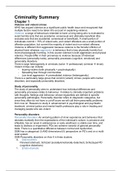Criminality Summary
Chapter 1
Violence and violent crimes
WHO has argued violence as a significant public health issue and recognized that
multiple factors need to be taken into account in explaining violence.
Violence: a range of behaviours intended to harm a living being who is motivated to
avoid harmful acts that are accidental, consensual and ultimately beneficial (this
excludes acts that are accidental, consensual or beneficial). A small portion of
individuals commit > 75% of violent acts, and violent offenders are a small portion of
offender population, but commit the majority of violent and non-violent offenses.
Violence is different from aggression because violence is the forceful infliction of
physical harm whereas aggression is behaviour that is less physically harmful but
more physiologically harming. In this course violence is both aggression and physical
violence. People differ in their proneness to violence because of individual
differences (personality traits), personality processes (cognitive, emotional) and
personality disorders.
There is large heterogeneity in criminals (naïve professional) (criminal trivial).
Violent crimes can include:
- Injuring victims (both physically + psychologically)
- Spreading fear through communities
- Low level aggression premediated violence (heterogeneity)
There is a particularly large group that commit (violent) crimes: people with mental
disorders, and especially personality disorders.
Study of personality
The study of personality aims to understand how individual differences and
personality processes relate to behaviour. It relates to clinically important problems
with thoughts, feelings and behaviour whose regularities are defined in specific
personality pathologies. Personality disorder refers to diagnostic categories, but
since they often do not have a cut-off score we will call them personality problems
from now on. Reasons to study it: advancement in psychological and psychiatric
treatment: criminal justice and mental health professors play a role in treating and
managing people who are violent.
Personality disorders
Personality disorders: An enduring pattern of inner experience and behaviour that
deviates markedly from the expectations of the individual’s culture, is pervasive and
inflexible, has an onset in adolescence or early adulthood, is stable over time, and
leads to distress or impairment. PDs are extreme variants of general personality
traits. There is a quantitative difference between normal and dysfunction.
DSM has a categorical (I) AND dimensional (II) perspective on PD’s and on a multi-
axial system.
DSM Personality disorders on Axis II in three clusters:
A. Odd-eccentric
Paranoid (distrust), Schizoid (socially/emotionally detached), Schizotypal PD
(cognitive distortions)
1. Erratic-dramatic
, Antisocial (violation of rights of others), borderline (instability of mood), Histrionic
(excessive emotionality and attention-seeking), Narcissistic PD (grandiose, lack
of empathy)
C. Worried-anxious
Avoidant (socially inhibited), Dependent (clinging) and Obsessive-Compulsive
PD (perfectionist).
Psychopathy lacks specific status as a personality disorder in DSM-IV and ICD10,
although aspects of it are captures in antisocial and dissocial personality disorder.
Around 4.4% has a personality disorder, men (5.4) are more likely to have it (3.4).
Most of these are unlikely to be violent. Half of antisocial have not been violent in the
last 5 years. People in cluster B are 10 times more likely to have a criminal
conviction than those without. A & C did not seem to have an effect. People with
personality disorder are more likely to reoffend after discharge from hospital in
comparison to mentally ill offenders. Nestor suggested four fundamental personality
dimensions operate as clinical risk factors for violence. Generally saying, these traits
distinguish those who act violently from the majority that do not:
1. Impulse control
2. Affect regulation
3. Narcissism
4. Paranoid cognitive personality
Through identification of the specific personality dimensions that are associated with
high risk for violence, we may contribute to the elimination of the stigmatising
generalization that all personality disordered people are violent. PD PATIENTS IN
FORENSIC PSYCHIATRIC HOSPITALS ARE NOT REPRESENTATIVE OF ALL
PEOPLE WITH PDs.
Those we see in forensic psychiatric hospitals and prisons are there because they
present a risk and are not representative of all people with personality disorders.
Personality traits are neither necessary nor sufficient to explain violence (sole causal
factor is unlikely). Across the lifespan: interaction of biological, psychological, social
and contextual variables influence a person’s propensity for violence. It is important
to understand mechanisms whereby personality traits increase violence risk and that
mechanisms can be changed in order to reduce violence.
Circular reasoning
The relationship between the type of personality disorder and violence is apparently
strongest for antisocial personality disorder, which is unsurprising since aggressive
behaviour is one of the defining criteria of the disorder. There is a clear circulating of
reasoning here. Subordinate definition of psychopaths which doesn’t include
violence: (1) arrogant interpersonal style, (2) deficient affective experience, (3)
impulsive and irresponsible. If violence is part of the definition, then the incidence of
violence among those with APD is higher than those with diagnoses who do not
feature violence. The same problem presents itself in psychopathy. It is a generally
good predictor for future violence in convicted offenders is psychopathy; but the
items are a mix of descriptive behaviours (crime/violence) and explanatory variables
(traits).
Impulsiveness
But what is the relationship between personality and violence? -> some basic
characteristics are associated with an increase of violence. Impulsiveness (acting
without thinking) can lead to anti-social behaviour and aggression and low inhibition.
,It is unlikely that any one factor alone will contribute sufficiently to warrant
designation as the sole causal agent of violence. These mechanism that trigger the
risk of aggression and violence include emotional experiences, responses to social
cues and beliefs about the self and the world. Furthermore, inhibition in children can
lead to lower antisocial behaviour and aggression later on in life.
Considerations
Personality traits are neither necessary nor sufficient to explain violence, since a sole
causal factor is unlikely. Across an individual’s lifespan, there are interactions of
biological, psychological, social and contextual variables that increase or decrease a
person’s propensity for violence. It is thus important to understand mechanisms
whereby personality traits increase violence risk, and how we can change these
mechanisms!
There are more considerations to keep in mind when deciding whether a violent
person has a PD or not?
1. The degree of choice a person exercises in the use of violence (legal model).
2. Formal model of reference (psychological model). We must take into account
the criteria for diagnoses. A person may have problems to some degree, but
that degree may be insufficient to meet the level of diagnoses; this is the
disadvantage of a categorical model.
Punishment or treatment
The nature and degree of dysfunctioning decide whether punishment, treatment or
both works best.
Treatments work better than punishment!
Punishment aims:
o Signal for society: what is acceptable and what is not
o Prevent and reduce crime
Punishment does not reduce crime!! Reconviction rates 55-60%. Punitive measures
are thus not effective. Punishment can lead to behaviour change when it is
immediate and inevitable. If the individual can understand the punishment in relation
to the deed, and if punishment is likely to lead to a change in behaviour, then
perhaps punishment is warranted. OTHERWISE: punishment has a social function
but may not reduce future risk.
Cognitive behavioural therapy is effective: it reduces reducing reoffending by 30-40%
in adults and 60% in young offenders. It does this by changing behaviour! It is in the
criminal justice + forensic mental health setting (punish + treat). But not all offenders
with PDs are equally treatable. If violence is seen as driven by emotions, and if the
person claims an inability to control his behaviour in the face of strong emotions ->
treatment is an option. If violence is driven by what the perpetrator stands to gain
from violence, they may be seen as less deserving of treatment. This response is
even more likely where there is no expressed desire to change.
Psychological treatment on people with PD have proven to be highly effective.
Mitigation
In mitigating anti-social behaviour and violence, a psychological explanation or
psychiatric diagnoses needs to identify specific deficiencies that impair the agency of
the person diagnosed. The deficiency may affect the capacity of a person to make
rational decisions, or impair degree of awareness of harm. People with PD are
, usually viewed as being responsible for their behaviour and not warranting mitigation
in the same way as those with mental illness or learning disabilities. The basis of this
view lies in the perceived normality of these disorders. A disorder may
excuse/mitigate antisocial behaviour because the individual is not fully aware of the
legal or moral imperative to refrain from this behaviour or because that person toes
not understand consequences. In related to ASD there is a assumption that they
know the consequences and nonetheless still act out.
If we hold people responsible for their actions, then a proportionate punishment is a
reasonable option. Yet a final consideration to be taken into account is the effect of
punishment.
Further research on punishment/treatment
There are treatments available, but not that much for people with PDs. Research has
shown that CBT has good effects, but there is limited good quality research and
mainly this is focussed on BPD. Not all offenders with PDs are not representative of
all PD patients. There is further research needed on treatment’s effectiveness. This
would increase the confidence of mental health professionals, judiciary and clients.
Identifying treatment targets
Intermittent explosive disorder -> violence driven by emotion (anger) -> inability to
control behaviour -> emotional dysregulation -> I want less anger and more self-
control -> treatment is an option!
Psychopathy -> Violence driven by possible gains (control over others and material
benefits) -> I don’t need to change / I need to change in order to avoid punishment ->
Treatment rejecting and treatment rejected. -> However, they may still have
emotional and cognitive deficits leading to violence (absence of fear and empathy) ->
Reduce violence.
Antisocial Personality Disorder
The best traced developmental sequence is that which identifies early impulsivity as
a direct risk for adults DPF. Impulsiveness linked with low intelligence may be linked
to deficits in the executive functions of the brain and may indicate an impairment in
the abilities necessary for forward planning and goal-directed behaviour. This initial
risk for violent behaviour is moderated by harsh and inconsistent parenting. Conflict
and anti-social behaviour in families, school behaviour. The end result of this
developmental route leaves a poorly educated person with no work experience, uses
violence as a means of resolving interpersonal problems. It is a product of an
interaction between her personality and current opportunities. It can be stopped by
family support, parent training and school inclusion programs.





